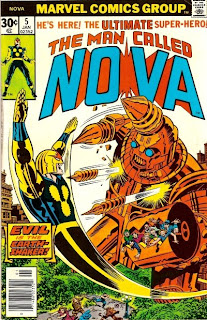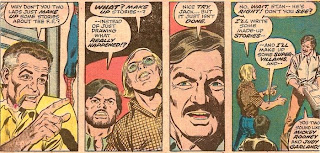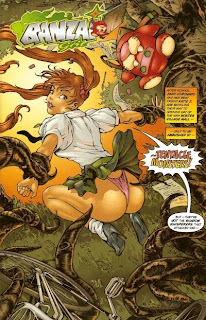
 The late 80's and early 90's were littered with independent comics publishers that sprung up almost literally overnight, published one or two issues of a book or two, then disappeared without a trace. And it sometimes seems as if half of them were edited by David Campiti (who now runs a company called Glass House Graphics, which boasts a certain Jinky Coronado among its creators--according to Wikipedia, Campiti can also boast a certain Jinky Coronado as his wife).
The late 80's and early 90's were littered with independent comics publishers that sprung up almost literally overnight, published one or two issues of a book or two, then disappeared without a trace. And it sometimes seems as if half of them were edited by David Campiti (who now runs a company called Glass House Graphics, which boasts a certain Jinky Coronado among its creators--according to Wikipedia, Campiti can also boast a certain Jinky Coronado as his wife).One such company was Wonder Color Comics, which lasted long enough to publish single issues of three titles, before shutting its doors. One of those titles was Power Factor #1, published in 1987, written by Kevin Juaire and drawn by Tom Lyle and Doug Hazlewood.
The cover features the central problem with Power Factor in a nutshell. There are four characters on the cover: a costumed archer holding the body of another costumed hero on the left, and two shadowy figures in some sort of blue dimensional rift on the right.
None of those characters appear in the story. Some of their costumes appear on mannequins, however.
That doesn't make any sense, I know. Let's try it this way: Power Factor is the story of...
No, that doesn't really work, either. Let's try it this way:
The story opens in 1965 with a meeting between crime bosses. The main Boss (who is not named in the scene) explains to the representatives of the other syndicates that costumed superheroes are no cause for panic. He displays a mannequin wearing a bullet-riddled costume and says that any hero who wears a costume will soon be dead.
 He then gives his son Michael a squirt gun. Michael recoils, saying "That's a bad guy's gun. I wanted to be a cop." I have no idea how you can tell a bad squirt gun from a good squirt gun, but roll with it.
He then gives his son Michael a squirt gun. Michael recoils, saying "That's a bad guy's gun. I wanted to be a cop." I have no idea how you can tell a bad squirt gun from a good squirt gun, but roll with it.We then see a flying superhero confront a couple of street thugs. Bullets bounce off him, and the toughs turn to run. But then a homeless guy pulls out a huge freaking blaster and blows a hole in the hero. The Boss (or maybe a boss, the art is unclear) steps out and tells his underlings to collect the costume.
In the Boss's office, a few years later, we see he has a gallery of mannequins in costumes representing all the heroes he has killed. While he's gone, however, his son Michael, who still has no idea what his dad does for a living, sneaks into the office and tries one of the costumes on. The Boss comes back and tells Michael that he should hold no reverence for costumes, because the "heroes" who wear them are the enemies of his Family.
Ten years later, Michael has joined the family business. The Boss's right hand man, Julius, tells him, "There's no secret whose son you are, Michael." Then in the next panel, Julius takes a phone call and announces, "Larson Grant is dead."
Who?
Apparently, Larson Grant was the name of the Boss (so it sort of was a secret whose son Michael was, at least to the readers). So now Michael is the new head of the syndicate.
Seven years later, it's 1987, and two men are meeting in a small kitchen. Sam Drake has superpowers and has been on the run for twenty years. Josh Kennedy, an old black ex-coach who walks with a cane, asks Sam how many times he's tried to kill himself.
The two men then confront a third man, identified only as Ferret. Ferret was a costumed hero who was "convinced" to retire by the mob. Sam and Josh tell Ferret they have a plan to revive the costumes, but Ferret flees. When Sam tracks him down, Ferret says he was ordered to retire or lose his wife and child. No way will he ever wear the Ferret costume again.
So Sam says "Be somebody else," and dumps a dozen costumes onto the ground (stolen from the mannequins in Michael's office).
And there, twenty pages in, we finally get to the crux of the concept of Power Factor. The premise is that a hero wearing a costume would be easy to kill, because the bad guys could just study him till they found a weakness: discovered a vulnerability in his powers, a flaw in his tactics, or failing that, just figured out his secret identity and threatened his family. Power Factor, then, is a group of heroes dressed in the costumes of dead heroes, who switch those costumes back and forth, so the bad guys never know exactly whom they dealing with.
This isn't completely spelled out in the story, mind you. We have a scene of Josh recruiting another hero for their stable, and then a scene where Sam Drake, dressed in the costume young Michael tried on so many years ago, confronts the grown Michael and basically says, "We're back." The first issue ends with Michael contemplating his bad guy squirt gun in an old trunk.
No, the premise is spelled out in way too much detail in a three-page text feature following the story. Editor Campiti waxes ecstatic about how awesomely different Power Factor will be from other super-team books, with an oblique slam at Watchmen thrown in for good measure. Three full pages to tell you what I said in one paragraph above.
 Well, you can probably understand why Power Factor didn't take off. It was all about the concept. Ideas are cheap; what matters is the execution. Which is not to say Power Factor was horribly written or drawn. Writer Kevin Juaire did some interesting things with structure that showed he had at least a clue about storytelling. And artists Tom Lyle and Doug Hazlewood turned in a competent art job that foreshadowed their later work for DC (Lyle as penciller of Starman and Hazlewood as inker of Adventures of Superman, among others).
Well, you can probably understand why Power Factor didn't take off. It was all about the concept. Ideas are cheap; what matters is the execution. Which is not to say Power Factor was horribly written or drawn. Writer Kevin Juaire did some interesting things with structure that showed he had at least a clue about storytelling. And artists Tom Lyle and Doug Hazlewood turned in a competent art job that foreshadowed their later work for DC (Lyle as penciller of Starman and Hazlewood as inker of Adventures of Superman, among others).But what makes a series really take off is characters. And Power Factor just doesn't have them. The most distinctive character in the book, the Boss, dies halfway through the story. The "heroes" of the series, Sam and Josh, appear without fanfare late in the book, and spend most of their time standing around conversing casually with other characters they've never met. Meanwhile, fully a third of the book, seven pages, is devoted to anonymous heroes being killed off. We never know who they are, and we don't care, because they're dead within a few panels.
By the end of the first issue, there was no tension, no mystery, no excitement. Wonder Color Comics folded after this was published. A second issue was published (with art by Carmine Infantino, supposedly) by Pied Piper Comics before that company, too, folded.
















